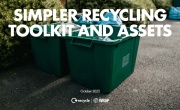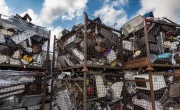Textiles do more damage to climate than plastic
Clothing causes more climate change than plastic, according to a new carbon metric report by Zero Waste Scotland (ZWS). The report shows the cost to the climate of the items commonly thrown away from homes in Scotland.

Textiles like clothing and shoes have long supply chains and generate large volumes of emissions at every stage – from growing fibres like cotton to manufacturing them into wearable goods to packaging and transporting them.
ZWS says that only five per cent of people are aware that clothing is the worst type of waste for the climate, with 61 per cent saying it’s plastic. 14 per cent of people say they think about the environmental impact of the garments they buy.
ZWS carbon metric tool and textiles
Zero Waste Scotland’s carbon metric tool tracks the full lifecycle impacts of items thrown away from Scotland’s homes, which it says makes for a more reliable picture than the traditional measure of waste by weight.
It is updated on an annual basis using the Scottish Environment Protection Agency’s (SEPA’s) latest published waste data. The data included in the newest carbon metric report is from 2021.
In the report, the term ‘textiles’ refers to a waste stream incorporating clothing, shoes and household goods like carpets.
Other household waste types identified as particularly damaging to the environment include food waste – which makes up 18 per cent of household waste by weight but causes 30 per cent of emissions from that waste.
ZWS adds that four-fifths of Scotland’s carbon footprint comes from products and materials aimed at consumers.
EuRIC's cautionary advice on used textiles export data
Joining the calls for more stringent data around material use to understand the full environmental impact of textiles is the European Recycling Industries' Confederation (EuRIC).
Off the back of a briefing published by the European Environment Agency (EEA) on EU trends in the export of used textiles, EuRIC has highlighted that the lack of distinction between textile waste and second-hand textiles in EU product classifications used for export declarations and statistical declarations for trade. As reuse and recycling capacities in Europe are limited, a large share of used textiles collected in the EU is traded and exported to Africa and Asia, and their fate is highly uncertain.
EuRIC says that vague or inaccurate statistics on exports of 'used clothing' is a problem because the second-hand market has a vastly different environmental impact to that of textile waste. Second-hand clothing can often be reused as it is, whereas textile waste needs further processing. While the latter is still preferable to virgin textile production, if second-hand clothing is put together with textile waste, then the opportunity for a second life without processing is lost.
According to a recent study commissioned by EuRIC, producing new textiles results in 70 times more environmental damage compared to global reuse. For instance, each reused garment saves 3kg of CO2, meaning that global or local reuse is still the best option for the environment in terms of the treatment of collected textile waste.
EuRIC says that to enable a sustainable circular economy for textiles, it is of utmost importance that only extensively sorted textiles are exported outside of the EU for reuse and that European and global recycling capacities are scaled up.
Mariska Boer, President of the EuRIC textile branch, said: “We fully support the EU’s intention to develop specific EU criteria to distinguish between waste and second-hand textiles and are encouraged to see this acknowledged in the EEA briefing.
“In the absence of this distinction, exports of sorted reusable textiles are understood to be equivalent to exports of unsorted textile waste. This often leads to misinterpretations.
“Our industry calls on the European Commission to urgently establish a distinction. Additionally, we support the introduction of measures, including fiscal initiatives, to strengthen the market for textile reuse and scale up recycling in the EU.”
ZWS partners with The Rebel Bear to reduce textile waste
A partnership between Zero Waste Scotland and Scottish street artist The Rebel Bear showcases the extent of the issue, with huge outdoor artworks popping up in two Scottish cities.
Hokusai's The Great Wave is reworked as a tsunami of waste clothes which has been painted on a hoarding at the former Debenhams store at the St Enoch Centre on Glasgow's Argyle Street. In Dundee, another hoarding beside Slessor Gardens shows a new version of Munch's The Scream with the well-known figure surrounded by piles of new clothing.
Iain Gulland, Chief Executive of Zero Waste Scotland, said: “If we’re serious about tackling climate change we need to rethink our consumption of goods and materials.
“The average Scot consumes more than twice the sustainable amount of materials per year¹, and our throwaway culture encourages that approach. It’s an environmental imperative that we turn this around, and The Rebel Bear’s artworks confront that reality in a really stark, and visually engaging, way.
“The circular economy gives us the opportunity [to] do things differently without compromising on quality of life, evolving an economy that’s better for both people and planet in which goods and materials are valued and made to last.
“Our campaign and the thought-provoking content within it is designed to empower everyone in Scotland to cut the environmental impact of our consumption down to size.”






